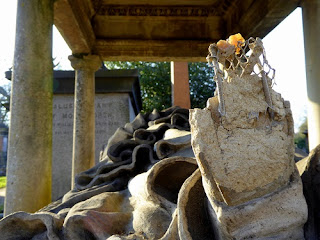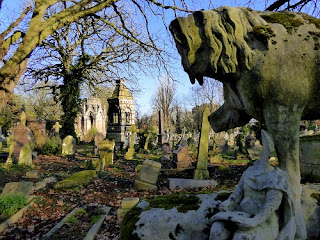Thursday, 21 March 2019
Discovering Kensal Green Cemetery
It speaks volumes for London's infinite riches that I'd never been here before attending a (pre-)birthday commemoration of Niagara ropewalker Charles Blondin (born 28 February 1824) by his grave. Not that I knew much about this extraordinary man; it was enough to clock that on one of his crossings above Niagara falls he cooked an omelette and ate it. This year the near-birthday fest took place during that period of freakishly warm, May-like February weather before the winds and hailstones. Wondered if we'd find the grave once we reached the neoclassical Anglican chapel at the head of the central avenue, but there through the columns the gathering could be seen.
The small party is organised annually by fellow funambulist Hermine Demoriane, now a writer and singer, a friend of J, so along we went to hear poems
read by, among others, Hermine's husband the poet Hugo Williams, with whom I once shared a flat in Edinburgh during the festival as a fellow writer on The Sunday Correspondent (he covered theatre, I classical music and opera alongside my pal Ed Seckerson). That's him with his back to the camera.
The big performance was the one by Silvia Ziranek, word-music matched to unforgettable images.
Pink much favoured, with a designer's eye for detail.
I took in the gist subliminally and admired its culmination, which was a tightrope walk of the imagination.
This was the first of the 'magnificent seven' landscaped cemeteries to be opened, by The General Cemetery Company in 1823. It's still a working cemetery, with recent graves marking the latest populations to move in to the area; Ethiopians (Amharic Christians, presumably) predominate. There was a power struggle over whether to construct the main buildings in Gothic or Neoclassical style; the latter won. John Griffiths' central edifice has Doric columns for the Anglican chapel and Ionic for the Dissenters. Must go on a proper tour one day to see the (restored) hydraulic systems for the catacombs. But there was still plenty to see in terms of monuments which excel anything to be found in our local, Brompton Cemetery, despite its magnificent overall design modelled on St Peter's Rome and its approach. Père Lachaise was an influence here, but the slope upwards is less pronounced, and there's more space.
Four servants of the British Raj guard the effigy for Sir William Casement, early 19th century Administrator of India.
Artificial stone is used both here and in the canopied resting place of Victorian artist William Mulready
as you can see from where the outer casing of 'Pulhamite' has worn away on one of the feet.
Perhaps the loveliest figures are the four angels on this neoclassical tomb
but unquestionably the most original in terms of detail is Andrew Ducrow's 'Egyptian' memorial, initially for his first wife before Ducrow shared his second thoughts in a ridiculous inscription: 'This tomb is erected by genius for the reception of its own remains'. Ducrow was proprietor of, and virtuoso performer in, the horsey 'Astley's Amphitheatre'. His memorial aroused the ireful verdict of 'ponderous coxcombery'.
Sphinxes flank two sides
and this is curious, a lady's hat and gloves on a fallen column.
Opposite the east side is this humbler and much damaged horse and child on another tomb for an equestrian and circus-horse breeder, Alfred Cooke.
Of the more well-known inhabitants, not all are buried here. But a memorial to the great Victorian illustrator George Cruikshank suffices to inform readers of his temperance.
Along the south side of the cemetery run water gates to allow for admission of coffins borne along the Grand Union Canal. You have to go down there to see it, but the remains of Kensal Gasworks, where a huge housing scheme is afoot, can be seen from many points, at least before the trees come into leaf.
At this end of the slope, near the gate, there are a few homages to the Gothic taste that lost out in the bigger scheme of things.
I'm grateful for some of the information here to a book I bought on the offchance. The Magnificent Seven: London's First Landscaped Cemeteries by John Turpin and Derrick Knight. It turns out to be more pictures than text, but good ones, and has inspired me to head off to the sites I don't know.
Subscribe to:
Post Comments (Atom)































8 comments:
"A working cemetery ", if not an oxymoron, is a phrase that gives rise to interesting speculations. And, despite the Ethiopians, one can also speculate that in 100 years time the Nice successor ( should should a thing be possible) will be looking at the same tombs, since cremation gives rise to no more than plaques, if that. Or perhaps in 100 years time they will live for ever
Yes, I was aware of its oxymoronic nature when I put that, but I like it. There will be no Nice successor, though I believe the two children of my cousin Chris will carry on the name in this branch of the family. I do like the fact that if the tombs aren't properly tended, nature slowly takes over - toppling, cracking and foliaging.
I was thinking not of your physical kin but of your spiritual successors, as presumably there will be some who knowingly or unknowingly follow your brilliant trajectory? And when we contemplate the fact that we like your tombs will be overcome by nature ( or burnt to avoid nature) we can only say with Bede -
“The present life of man upon earth, O King, seems to me in comparison with that time which is unknown to us like the swift flight of a sparrow through the mead-hall where you sit at supper in winter, with your Ealdormen and thanes, while the fire blazes in the midst and the hall is warmed, but the wintry storms of rain or snow are raging abroad. The sparrow, flying in at one door and immediately out at another, whilst he is within, is safe from the wintry tempest, but after a short space of fair weather, he immediately vanishes out of your sight, passing from winter to winter again. So this life of man appears for a little while, but of what is to follow or what went before we know nothing at all.”
Oh, I see. Well, curiosity will never die, will it? I only just noticed the epigraph to the excellent blog of Josie Holford: 'Be kind, have courage, be curious'.
Treasurable quotation, thank you. Chimes with a short story I've just read by the too-long-hidden Soviet era writer Andrey Platonov, 'Love for the Motherland or, The Sparrow's Journey'. Said bird is one Russian image for the soul, apparently.
"A (pre-)birthday commemoration of Niagara ropewalker Charles Blondin"? Whatever next! It does look to have been a delightful affair. And of course I had to look him up, and found, among many other interesting details, this: "During the run-up to the United States presidential election, 1864, Abraham Lincoln compared himself to 'Blondin on the tightrope, with all that was valuable to America in the wheelbarrow he was pushing before him.'"
And indeed, curiosity will--and should--never die!
Isn't that a coincidence? I was thinking about George Saunders, of 'Lincoln in the Bardo', which still haunts me, and how he might connect with Blondin somehow...I also went straight back to the first chapter of Jaan Kross's trilogy and its virtuoso description of the ropewalkers going from the tower of Tallinn's St Olav. Must hunt out a good short biography of our funambulist...
I truly love the trail of connections you’ve made, to two wonderful books.
Good news: Kross Vol. 3 is due to appear in the summer. Lembit's mother must have rallied. I do wish her all the best; her contribution to literary history is now assured. Translators are heroic (and underpaid!)
Post a Comment